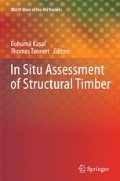Abstract
Resistance drilling is based on the correlation between cutting (drilling) resistance and material density and hardness. Small needle-like drill bit is driven into the material with a constant speed and feed rate. Energy needed for the drill to proceed is recorded as a function of the bit position. The resistance-position plot is then used to make inferences on material (voids-no voids). Appropriate drill but size (diameter) must be selected to avoid bending the drill along the late wood annual rings. Correlation between wood mechanical properties and drilling resistance is poor. Core drilling is a local method and gives localized information about the member quality at the location of the test only.
Access this chapter
Tax calculation will be finalised at checkout
Purchases are for personal use only
Preview
Unable to display preview. Download preview PDF.
References
Brashaw, B., Vatalaro, R.J., Wacker, J.P., Ross, R.J.: Condition assessment of timber bridges: 1. Evaluation of a micro-drilling tool. Gen. Tech. Rep. FPL-GTR-159. US Department of Agriculture, Forest Service, Forest Products Laboratory, Madison, WI (2005)
Kasal, B., Anthony, R.: Advances in in situ evaluation of timber structures. Progress in Structural Engineering and Materials 6(2), 94–103 (2004)
Vermeer Australia. The IML Resistograph (July 20, 2005), http://www.vermeeraustralia.com
Rinn, F., Schweingruber, F.H., Schär, E.: Resistograph and X-ray density charts of wood. Comparative evaluation of drill resistance profiles and X-ray density charts of different wood species. Holzforschung 50, 303–311 (1996)
Feio, A.O., Machado, J.S., Lourenco, P.B.: Parallel to the grain behavior and NDT correlations for chestnut wood (Castanea Sativa Mill). In: Proceedings Conservation of Historic Wooden Structures, Florence, Italy, pp. 294–303 (2005)
Editor information
Editors and Affiliations
Rights and permissions
Copyright information
© 2010 Springer Netherlands
About this chapter
Cite this chapter
Lear, G., Kasal, B., Anthony, R. (2010). Resistance Drilling. In: Kasal, B., Tannert, T. (eds) In Situ Assessment of Structural Timber. RILEM State of the Art Reports, vol 7. Springer, Dordrecht. https://doi.org/10.1007/978-94-007-0560-9_5
Download citation
DOI: https://doi.org/10.1007/978-94-007-0560-9_5
Publisher Name: Springer, Dordrecht
Print ISBN: 978-94-007-0559-3
Online ISBN: 978-94-007-0560-9
eBook Packages: EngineeringEngineering (R0)

